Canadian Social History: Native People Before and After Confederation
VerifiedAdded on 2022/12/27
|10
|2857
|89
Essay
AI Summary
This essay delves into the social history of Canada, specifically examining the lives of native and indigenous peoples before and after the Confederation of 1867. The paper argues that the native population experienced a decline in their living conditions and rights following Confederation, primarily due to the actions of British colonists. The essay explores the impact of treaties, the Royal Proclamation of 1763, and the British government's policies aimed at assimilating indigenous populations into Euro-Canadian society. It highlights the shift from a period of cooperation to one of domination, analyzing the loss of land, restricted voting rights, and the forced assimilation of indigenous children. The essay utilizes scholarly sources to support the argument that the native people were better off before Confederation and faced significant challenges in maintaining their culture and independence under the new political framework.
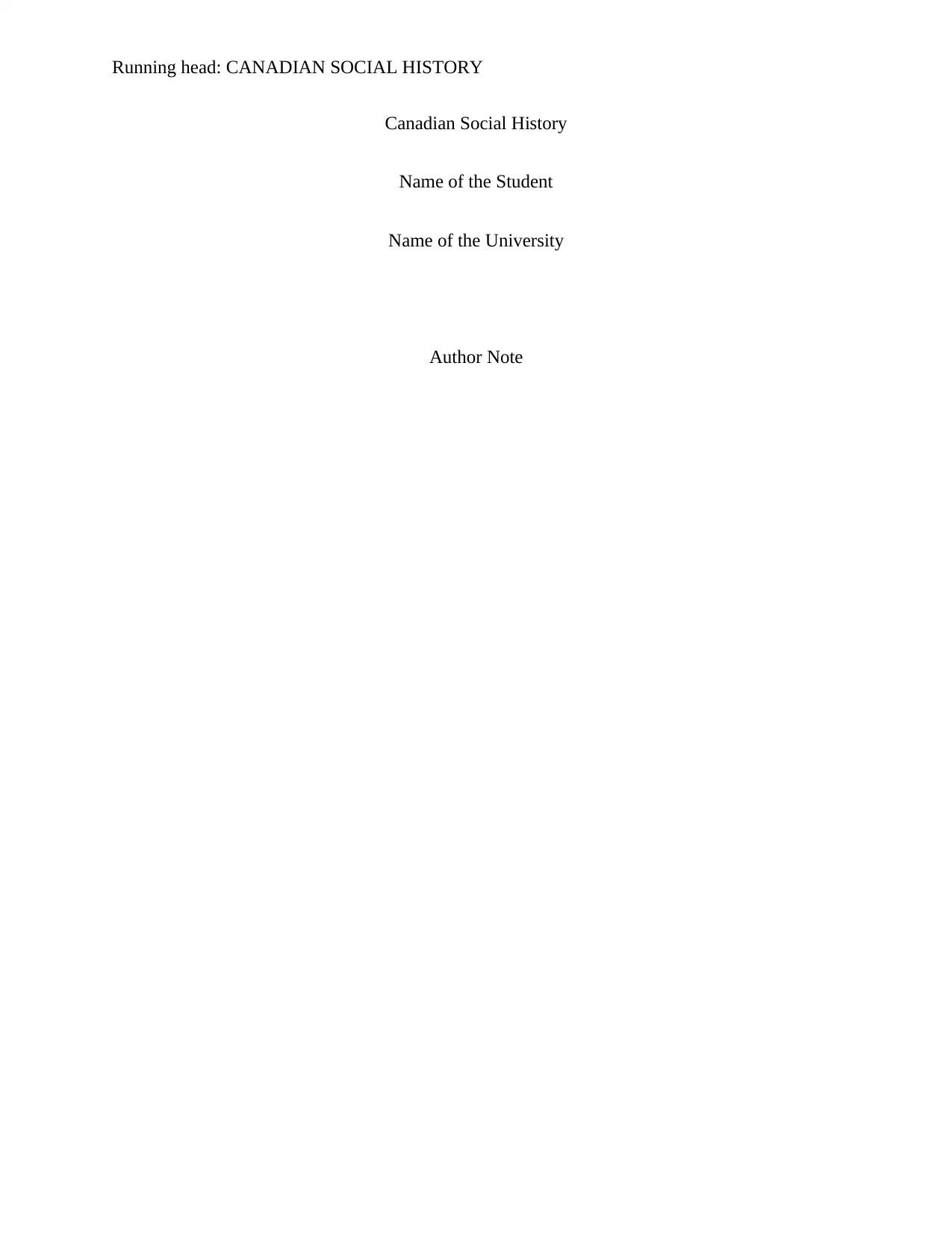
Running head: CANADIAN SOCIAL HISTORY
Canadian Social History
Name of the Student
Name of the University
Author Note
Canadian Social History
Name of the Student
Name of the University
Author Note
Paraphrase This Document
Need a fresh take? Get an instant paraphrase of this document with our AI Paraphraser
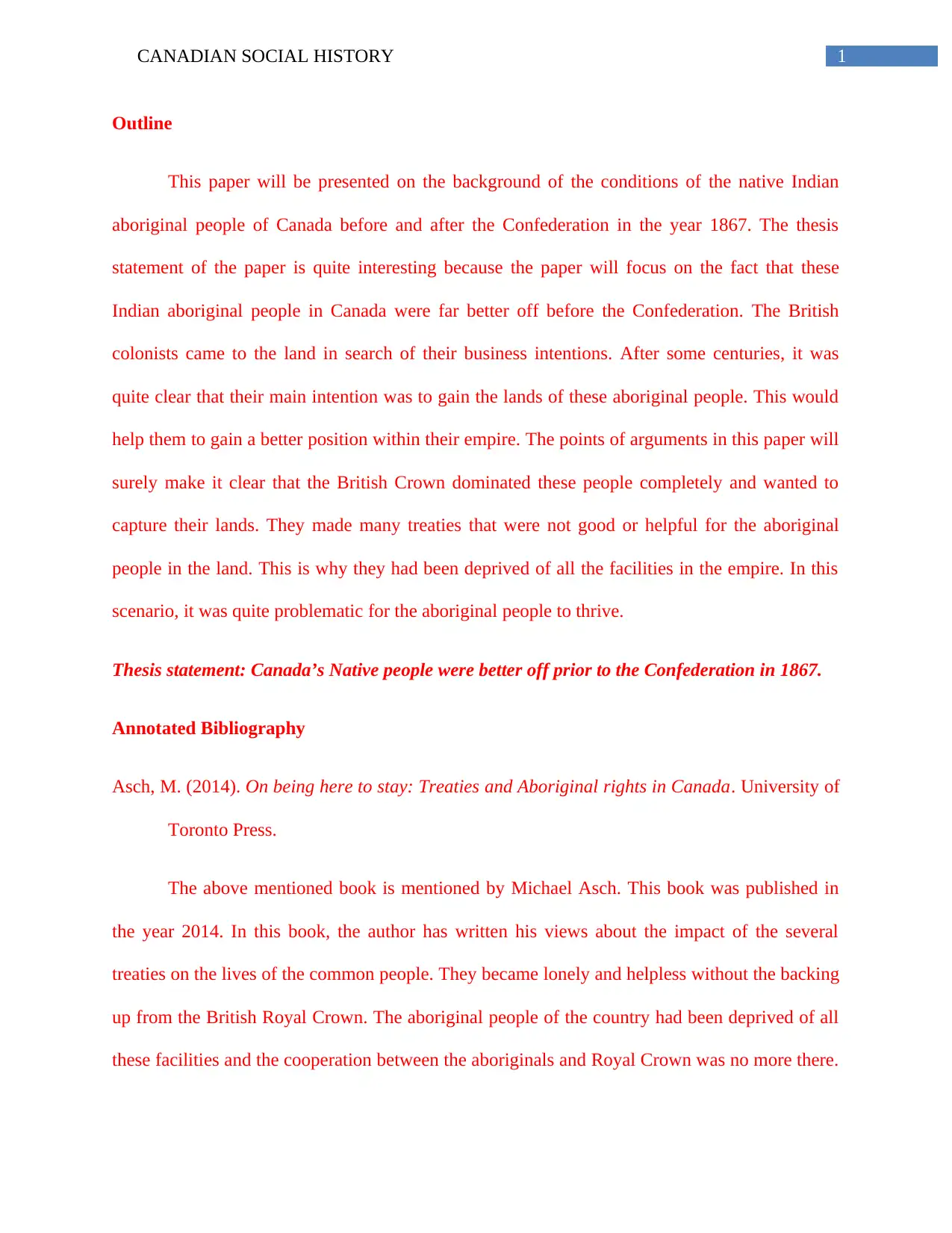
1CANADIAN SOCIAL HISTORY
Outline
This paper will be presented on the background of the conditions of the native Indian
aboriginal people of Canada before and after the Confederation in the year 1867. The thesis
statement of the paper is quite interesting because the paper will focus on the fact that these
Indian aboriginal people in Canada were far better off before the Confederation. The British
colonists came to the land in search of their business intentions. After some centuries, it was
quite clear that their main intention was to gain the lands of these aboriginal people. This would
help them to gain a better position within their empire. The points of arguments in this paper will
surely make it clear that the British Crown dominated these people completely and wanted to
capture their lands. They made many treaties that were not good or helpful for the aboriginal
people in the land. This is why they had been deprived of all the facilities in the empire. In this
scenario, it was quite problematic for the aboriginal people to thrive.
Thesis statement: Canada’s Native people were better off prior to the Confederation in 1867.
Annotated Bibliography
Asch, M. (2014). On being here to stay: Treaties and Aboriginal rights in Canada. University of
Toronto Press.
The above mentioned book is mentioned by Michael Asch. This book was published in
the year 2014. In this book, the author has written his views about the impact of the several
treaties on the lives of the common people. They became lonely and helpless without the backing
up from the British Royal Crown. The aboriginal people of the country had been deprived of all
these facilities and the cooperation between the aboriginals and Royal Crown was no more there.
Outline
This paper will be presented on the background of the conditions of the native Indian
aboriginal people of Canada before and after the Confederation in the year 1867. The thesis
statement of the paper is quite interesting because the paper will focus on the fact that these
Indian aboriginal people in Canada were far better off before the Confederation. The British
colonists came to the land in search of their business intentions. After some centuries, it was
quite clear that their main intention was to gain the lands of these aboriginal people. This would
help them to gain a better position within their empire. The points of arguments in this paper will
surely make it clear that the British Crown dominated these people completely and wanted to
capture their lands. They made many treaties that were not good or helpful for the aboriginal
people in the land. This is why they had been deprived of all the facilities in the empire. In this
scenario, it was quite problematic for the aboriginal people to thrive.
Thesis statement: Canada’s Native people were better off prior to the Confederation in 1867.
Annotated Bibliography
Asch, M. (2014). On being here to stay: Treaties and Aboriginal rights in Canada. University of
Toronto Press.
The above mentioned book is mentioned by Michael Asch. This book was published in
the year 2014. In this book, the author has written his views about the impact of the several
treaties on the lives of the common people. They became lonely and helpless without the backing
up from the British Royal Crown. The aboriginal people of the country had been deprived of all
these facilities and the cooperation between the aboriginals and Royal Crown was no more there.
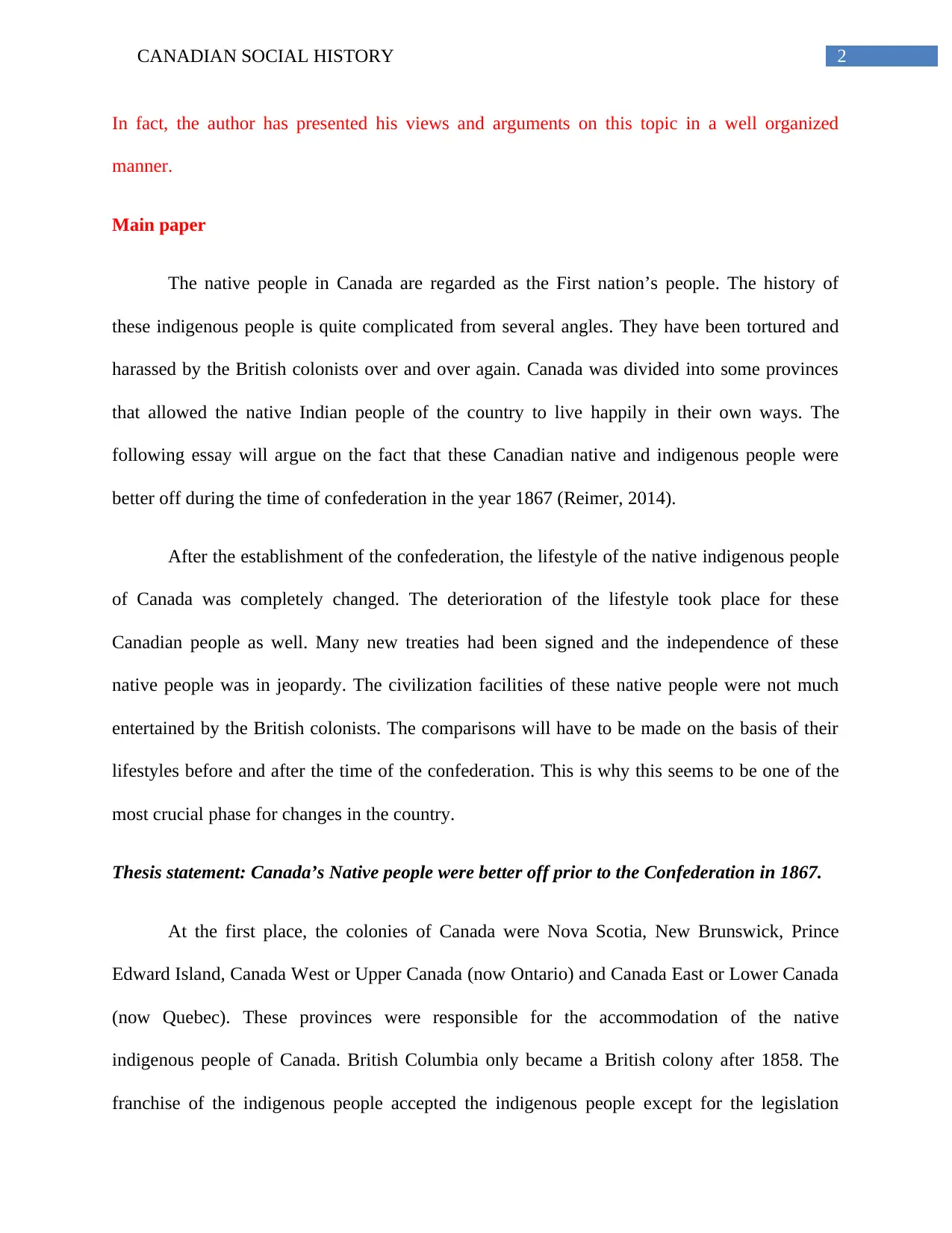
2CANADIAN SOCIAL HISTORY
In fact, the author has presented his views and arguments on this topic in a well organized
manner.
Main paper
The native people in Canada are regarded as the First nation’s people. The history of
these indigenous people is quite complicated from several angles. They have been tortured and
harassed by the British colonists over and over again. Canada was divided into some provinces
that allowed the native Indian people of the country to live happily in their own ways. The
following essay will argue on the fact that these Canadian native and indigenous people were
better off during the time of confederation in the year 1867 (Reimer, 2014).
After the establishment of the confederation, the lifestyle of the native indigenous people
of Canada was completely changed. The deterioration of the lifestyle took place for these
Canadian people as well. Many new treaties had been signed and the independence of these
native people was in jeopardy. The civilization facilities of these native people were not much
entertained by the British colonists. The comparisons will have to be made on the basis of their
lifestyles before and after the time of the confederation. This is why this seems to be one of the
most crucial phase for changes in the country.
Thesis statement: Canada’s Native people were better off prior to the Confederation in 1867.
At the first place, the colonies of Canada were Nova Scotia, New Brunswick, Prince
Edward Island, Canada West or Upper Canada (now Ontario) and Canada East or Lower Canada
(now Quebec). These provinces were responsible for the accommodation of the native
indigenous people of Canada. British Columbia only became a British colony after 1858. The
franchise of the indigenous people accepted the indigenous people except for the legislation
In fact, the author has presented his views and arguments on this topic in a well organized
manner.
Main paper
The native people in Canada are regarded as the First nation’s people. The history of
these indigenous people is quite complicated from several angles. They have been tortured and
harassed by the British colonists over and over again. Canada was divided into some provinces
that allowed the native Indian people of the country to live happily in their own ways. The
following essay will argue on the fact that these Canadian native and indigenous people were
better off during the time of confederation in the year 1867 (Reimer, 2014).
After the establishment of the confederation, the lifestyle of the native indigenous people
of Canada was completely changed. The deterioration of the lifestyle took place for these
Canadian people as well. Many new treaties had been signed and the independence of these
native people was in jeopardy. The civilization facilities of these native people were not much
entertained by the British colonists. The comparisons will have to be made on the basis of their
lifestyles before and after the time of the confederation. This is why this seems to be one of the
most crucial phase for changes in the country.
Thesis statement: Canada’s Native people were better off prior to the Confederation in 1867.
At the first place, the colonies of Canada were Nova Scotia, New Brunswick, Prince
Edward Island, Canada West or Upper Canada (now Ontario) and Canada East or Lower Canada
(now Quebec). These provinces were responsible for the accommodation of the native
indigenous people of Canada. British Columbia only became a British colony after 1858. The
franchise of the indigenous people accepted the indigenous people except for the legislation
⊘ This is a preview!⊘
Do you want full access?
Subscribe today to unlock all pages.

Trusted by 1+ million students worldwide
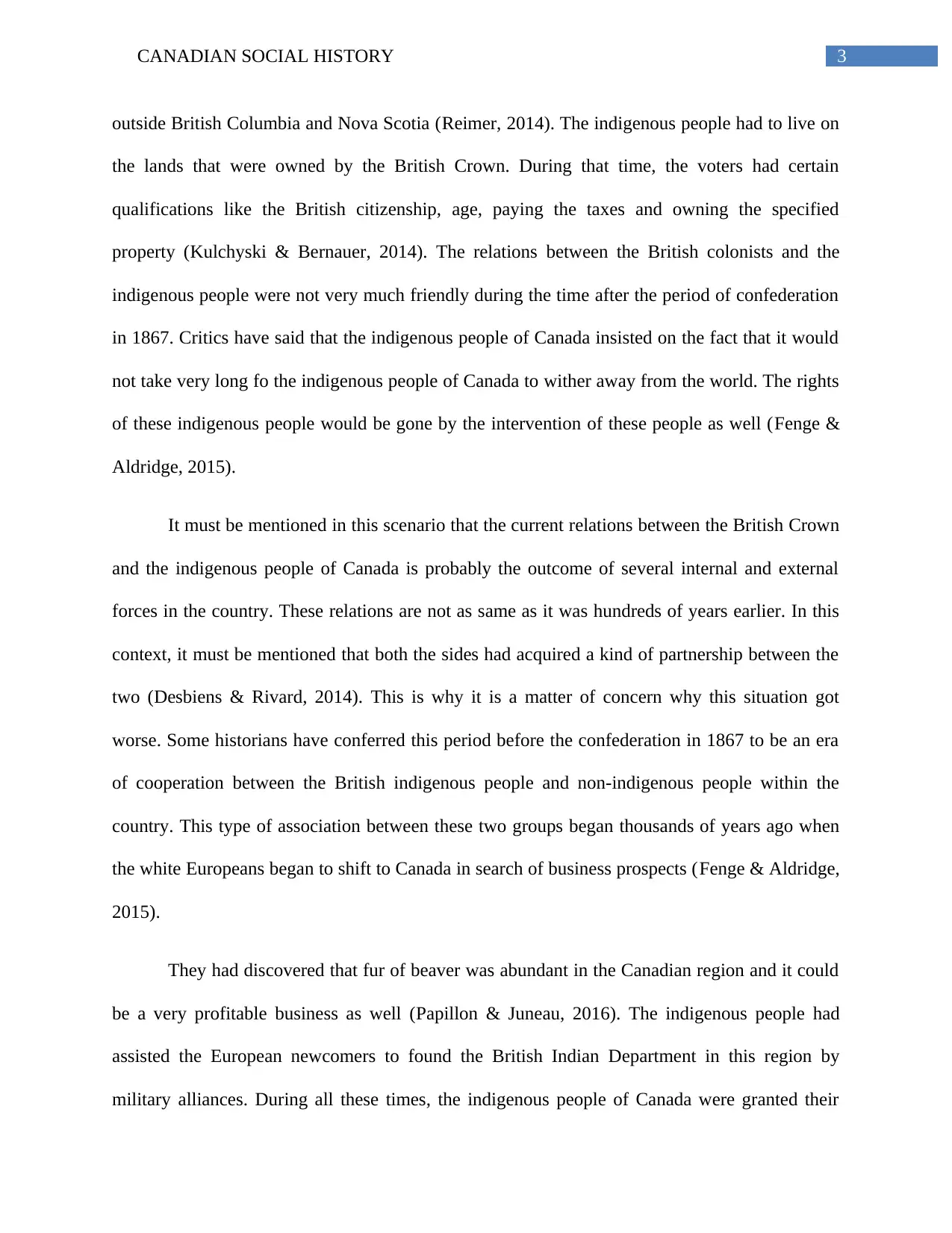
3CANADIAN SOCIAL HISTORY
outside British Columbia and Nova Scotia (Reimer, 2014). The indigenous people had to live on
the lands that were owned by the British Crown. During that time, the voters had certain
qualifications like the British citizenship, age, paying the taxes and owning the specified
property (Kulchyski & Bernauer, 2014). The relations between the British colonists and the
indigenous people were not very much friendly during the time after the period of confederation
in 1867. Critics have said that the indigenous people of Canada insisted on the fact that it would
not take very long fo the indigenous people of Canada to wither away from the world. The rights
of these indigenous people would be gone by the intervention of these people as well (Fenge &
Aldridge, 2015).
It must be mentioned in this scenario that the current relations between the British Crown
and the indigenous people of Canada is probably the outcome of several internal and external
forces in the country. These relations are not as same as it was hundreds of years earlier. In this
context, it must be mentioned that both the sides had acquired a kind of partnership between the
two (Desbiens & Rivard, 2014). This is why it is a matter of concern why this situation got
worse. Some historians have conferred this period before the confederation in 1867 to be an era
of cooperation between the British indigenous people and non-indigenous people within the
country. This type of association between these two groups began thousands of years ago when
the white Europeans began to shift to Canada in search of business prospects (Fenge & Aldridge,
2015).
They had discovered that fur of beaver was abundant in the Canadian region and it could
be a very profitable business as well (Papillon & Juneau, 2016). The indigenous people had
assisted the European newcomers to found the British Indian Department in this region by
military alliances. During all these times, the indigenous people of Canada were granted their
outside British Columbia and Nova Scotia (Reimer, 2014). The indigenous people had to live on
the lands that were owned by the British Crown. During that time, the voters had certain
qualifications like the British citizenship, age, paying the taxes and owning the specified
property (Kulchyski & Bernauer, 2014). The relations between the British colonists and the
indigenous people were not very much friendly during the time after the period of confederation
in 1867. Critics have said that the indigenous people of Canada insisted on the fact that it would
not take very long fo the indigenous people of Canada to wither away from the world. The rights
of these indigenous people would be gone by the intervention of these people as well (Fenge &
Aldridge, 2015).
It must be mentioned in this scenario that the current relations between the British Crown
and the indigenous people of Canada is probably the outcome of several internal and external
forces in the country. These relations are not as same as it was hundreds of years earlier. In this
context, it must be mentioned that both the sides had acquired a kind of partnership between the
two (Desbiens & Rivard, 2014). This is why it is a matter of concern why this situation got
worse. Some historians have conferred this period before the confederation in 1867 to be an era
of cooperation between the British indigenous people and non-indigenous people within the
country. This type of association between these two groups began thousands of years ago when
the white Europeans began to shift to Canada in search of business prospects (Fenge & Aldridge,
2015).
They had discovered that fur of beaver was abundant in the Canadian region and it could
be a very profitable business as well (Papillon & Juneau, 2016). The indigenous people had
assisted the European newcomers to found the British Indian Department in this region by
military alliances. During all these times, the indigenous people of Canada were granted their
Paraphrase This Document
Need a fresh take? Get an instant paraphrase of this document with our AI Paraphraser
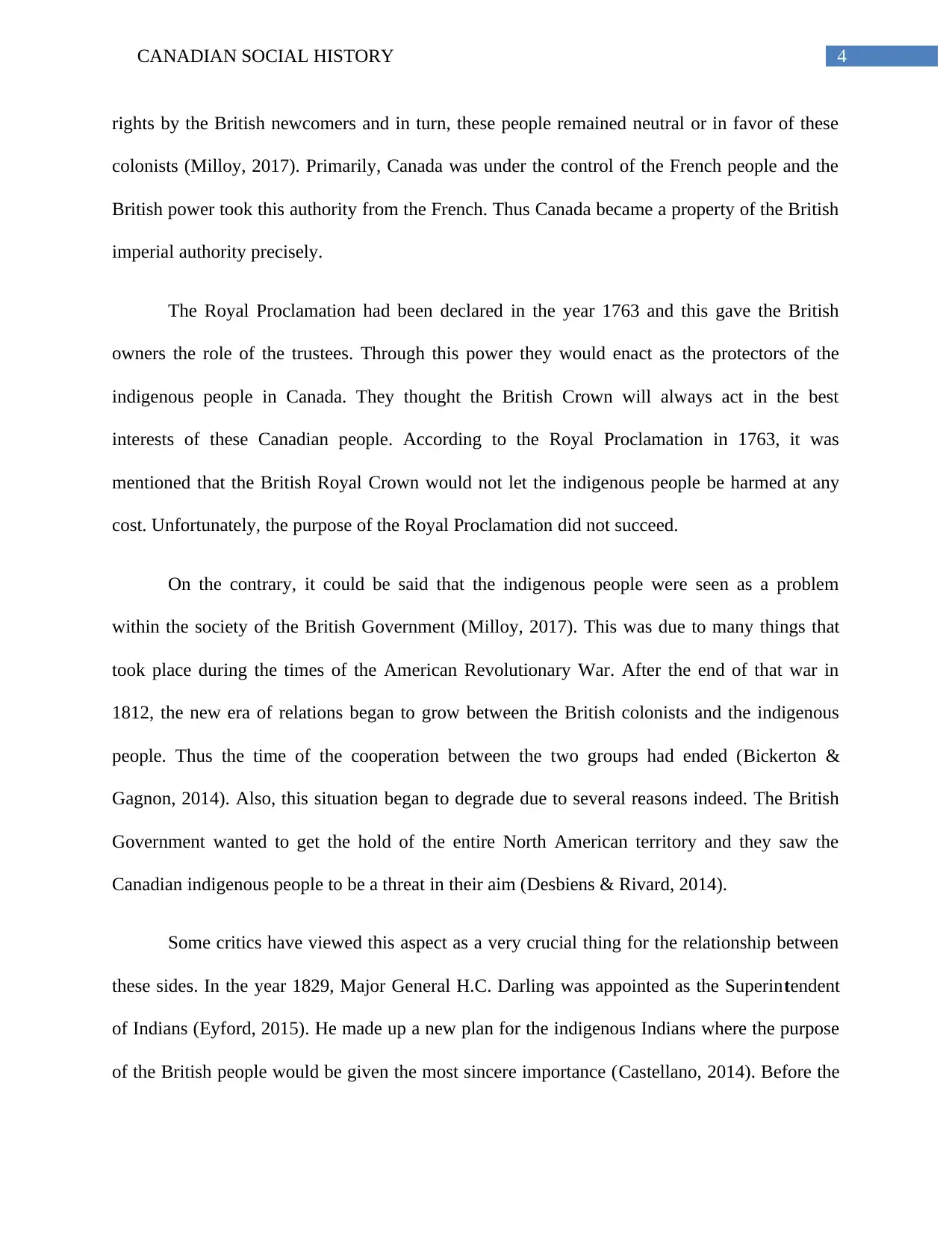
4CANADIAN SOCIAL HISTORY
rights by the British newcomers and in turn, these people remained neutral or in favor of these
colonists (Milloy, 2017). Primarily, Canada was under the control of the French people and the
British power took this authority from the French. Thus Canada became a property of the British
imperial authority precisely.
The Royal Proclamation had been declared in the year 1763 and this gave the British
owners the role of the trustees. Through this power they would enact as the protectors of the
indigenous people in Canada. They thought the British Crown will always act in the best
interests of these Canadian people. According to the Royal Proclamation in 1763, it was
mentioned that the British Royal Crown would not let the indigenous people be harmed at any
cost. Unfortunately, the purpose of the Royal Proclamation did not succeed.
On the contrary, it could be said that the indigenous people were seen as a problem
within the society of the British Government (Milloy, 2017). This was due to many things that
took place during the times of the American Revolutionary War. After the end of that war in
1812, the new era of relations began to grow between the British colonists and the indigenous
people. Thus the time of the cooperation between the two groups had ended (Bickerton &
Gagnon, 2014). Also, this situation began to degrade due to several reasons indeed. The British
Government wanted to get the hold of the entire North American territory and they saw the
Canadian indigenous people to be a threat in their aim (Desbiens & Rivard, 2014).
Some critics have viewed this aspect as a very crucial thing for the relationship between
these sides. In the year 1829, Major General H.C. Darling was appointed as the Superintendent
of Indians (Eyford, 2015). He made up a new plan for the indigenous Indians where the purpose
of the British people would be given the most sincere importance (Castellano, 2014). Before the
rights by the British newcomers and in turn, these people remained neutral or in favor of these
colonists (Milloy, 2017). Primarily, Canada was under the control of the French people and the
British power took this authority from the French. Thus Canada became a property of the British
imperial authority precisely.
The Royal Proclamation had been declared in the year 1763 and this gave the British
owners the role of the trustees. Through this power they would enact as the protectors of the
indigenous people in Canada. They thought the British Crown will always act in the best
interests of these Canadian people. According to the Royal Proclamation in 1763, it was
mentioned that the British Royal Crown would not let the indigenous people be harmed at any
cost. Unfortunately, the purpose of the Royal Proclamation did not succeed.
On the contrary, it could be said that the indigenous people were seen as a problem
within the society of the British Government (Milloy, 2017). This was due to many things that
took place during the times of the American Revolutionary War. After the end of that war in
1812, the new era of relations began to grow between the British colonists and the indigenous
people. Thus the time of the cooperation between the two groups had ended (Bickerton &
Gagnon, 2014). Also, this situation began to degrade due to several reasons indeed. The British
Government wanted to get the hold of the entire North American territory and they saw the
Canadian indigenous people to be a threat in their aim (Desbiens & Rivard, 2014).
Some critics have viewed this aspect as a very crucial thing for the relationship between
these sides. In the year 1829, Major General H.C. Darling was appointed as the Superintendent
of Indians (Eyford, 2015). He made up a new plan for the indigenous Indians where the purpose
of the British people would be given the most sincere importance (Castellano, 2014). Before the
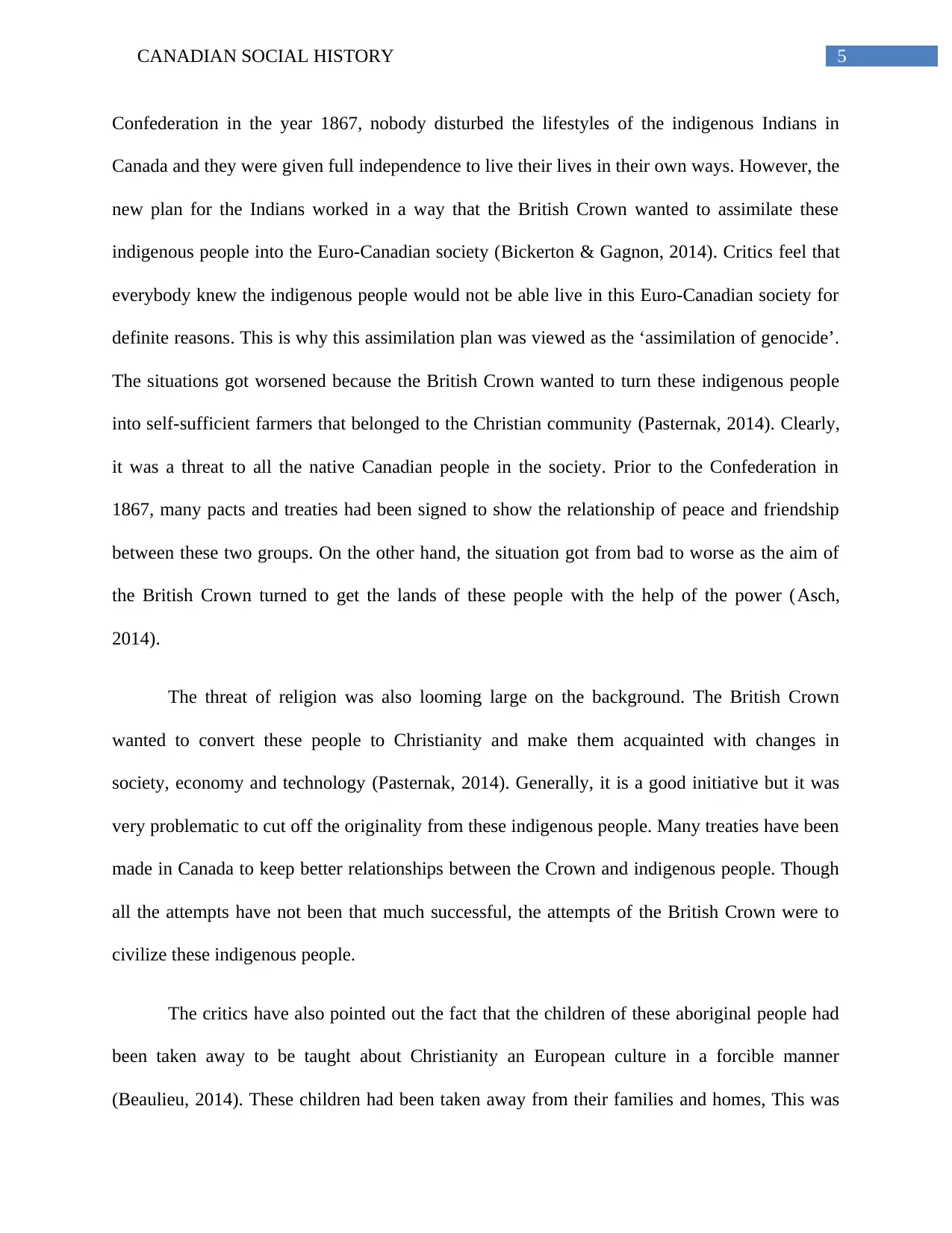
5CANADIAN SOCIAL HISTORY
Confederation in the year 1867, nobody disturbed the lifestyles of the indigenous Indians in
Canada and they were given full independence to live their lives in their own ways. However, the
new plan for the Indians worked in a way that the British Crown wanted to assimilate these
indigenous people into the Euro-Canadian society (Bickerton & Gagnon, 2014). Critics feel that
everybody knew the indigenous people would not be able live in this Euro-Canadian society for
definite reasons. This is why this assimilation plan was viewed as the ‘assimilation of genocide’.
The situations got worsened because the British Crown wanted to turn these indigenous people
into self-sufficient farmers that belonged to the Christian community (Pasternak, 2014). Clearly,
it was a threat to all the native Canadian people in the society. Prior to the Confederation in
1867, many pacts and treaties had been signed to show the relationship of peace and friendship
between these two groups. On the other hand, the situation got from bad to worse as the aim of
the British Crown turned to get the lands of these people with the help of the power (Asch,
2014).
The threat of religion was also looming large on the background. The British Crown
wanted to convert these people to Christianity and make them acquainted with changes in
society, economy and technology (Pasternak, 2014). Generally, it is a good initiative but it was
very problematic to cut off the originality from these indigenous people. Many treaties have been
made in Canada to keep better relationships between the Crown and indigenous people. Though
all the attempts have not been that much successful, the attempts of the British Crown were to
civilize these indigenous people.
The critics have also pointed out the fact that the children of these aboriginal people had
been taken away to be taught about Christianity an European culture in a forcible manner
(Beaulieu, 2014). These children had been taken away from their families and homes, This was
Confederation in the year 1867, nobody disturbed the lifestyles of the indigenous Indians in
Canada and they were given full independence to live their lives in their own ways. However, the
new plan for the Indians worked in a way that the British Crown wanted to assimilate these
indigenous people into the Euro-Canadian society (Bickerton & Gagnon, 2014). Critics feel that
everybody knew the indigenous people would not be able live in this Euro-Canadian society for
definite reasons. This is why this assimilation plan was viewed as the ‘assimilation of genocide’.
The situations got worsened because the British Crown wanted to turn these indigenous people
into self-sufficient farmers that belonged to the Christian community (Pasternak, 2014). Clearly,
it was a threat to all the native Canadian people in the society. Prior to the Confederation in
1867, many pacts and treaties had been signed to show the relationship of peace and friendship
between these two groups. On the other hand, the situation got from bad to worse as the aim of
the British Crown turned to get the lands of these people with the help of the power (Asch,
2014).
The threat of religion was also looming large on the background. The British Crown
wanted to convert these people to Christianity and make them acquainted with changes in
society, economy and technology (Pasternak, 2014). Generally, it is a good initiative but it was
very problematic to cut off the originality from these indigenous people. Many treaties have been
made in Canada to keep better relationships between the Crown and indigenous people. Though
all the attempts have not been that much successful, the attempts of the British Crown were to
civilize these indigenous people.
The critics have also pointed out the fact that the children of these aboriginal people had
been taken away to be taught about Christianity an European culture in a forcible manner
(Beaulieu, 2014). These children had been taken away from their families and homes, This was
⊘ This is a preview!⊘
Do you want full access?
Subscribe today to unlock all pages.

Trusted by 1+ million students worldwide
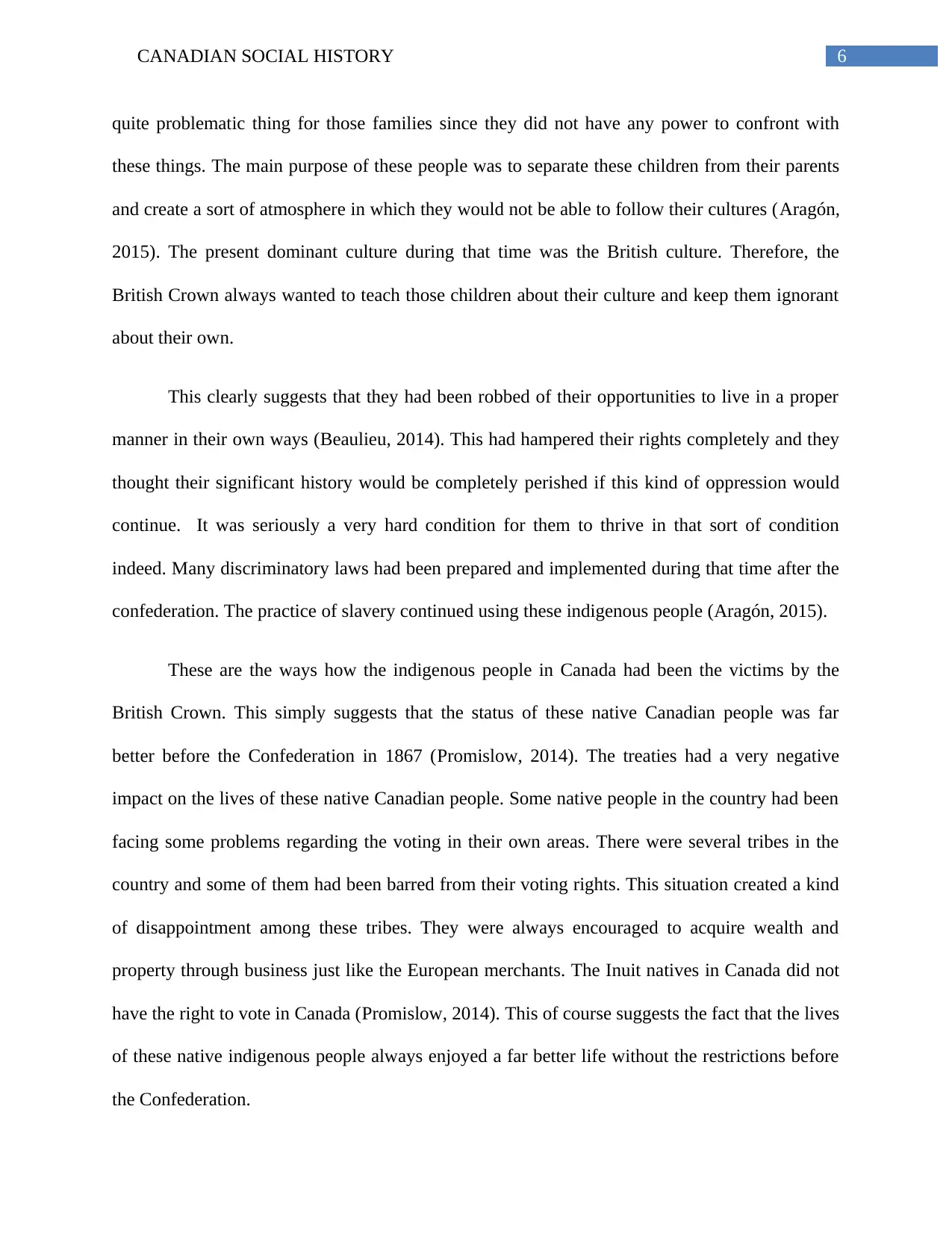
6CANADIAN SOCIAL HISTORY
quite problematic thing for those families since they did not have any power to confront with
these things. The main purpose of these people was to separate these children from their parents
and create a sort of atmosphere in which they would not be able to follow their cultures (Aragón,
2015). The present dominant culture during that time was the British culture. Therefore, the
British Crown always wanted to teach those children about their culture and keep them ignorant
about their own.
This clearly suggests that they had been robbed of their opportunities to live in a proper
manner in their own ways (Beaulieu, 2014). This had hampered their rights completely and they
thought their significant history would be completely perished if this kind of oppression would
continue. It was seriously a very hard condition for them to thrive in that sort of condition
indeed. Many discriminatory laws had been prepared and implemented during that time after the
confederation. The practice of slavery continued using these indigenous people (Aragón, 2015).
These are the ways how the indigenous people in Canada had been the victims by the
British Crown. This simply suggests that the status of these native Canadian people was far
better before the Confederation in 1867 (Promislow, 2014). The treaties had a very negative
impact on the lives of these native Canadian people. Some native people in the country had been
facing some problems regarding the voting in their own areas. There were several tribes in the
country and some of them had been barred from their voting rights. This situation created a kind
of disappointment among these tribes. They were always encouraged to acquire wealth and
property through business just like the European merchants. The Inuit natives in Canada did not
have the right to vote in Canada (Promislow, 2014). This of course suggests the fact that the lives
of these native indigenous people always enjoyed a far better life without the restrictions before
the Confederation.
quite problematic thing for those families since they did not have any power to confront with
these things. The main purpose of these people was to separate these children from their parents
and create a sort of atmosphere in which they would not be able to follow their cultures (Aragón,
2015). The present dominant culture during that time was the British culture. Therefore, the
British Crown always wanted to teach those children about their culture and keep them ignorant
about their own.
This clearly suggests that they had been robbed of their opportunities to live in a proper
manner in their own ways (Beaulieu, 2014). This had hampered their rights completely and they
thought their significant history would be completely perished if this kind of oppression would
continue. It was seriously a very hard condition for them to thrive in that sort of condition
indeed. Many discriminatory laws had been prepared and implemented during that time after the
confederation. The practice of slavery continued using these indigenous people (Aragón, 2015).
These are the ways how the indigenous people in Canada had been the victims by the
British Crown. This simply suggests that the status of these native Canadian people was far
better before the Confederation in 1867 (Promislow, 2014). The treaties had a very negative
impact on the lives of these native Canadian people. Some native people in the country had been
facing some problems regarding the voting in their own areas. There were several tribes in the
country and some of them had been barred from their voting rights. This situation created a kind
of disappointment among these tribes. They were always encouraged to acquire wealth and
property through business just like the European merchants. The Inuit natives in Canada did not
have the right to vote in Canada (Promislow, 2014). This of course suggests the fact that the lives
of these native indigenous people always enjoyed a far better life without the restrictions before
the Confederation.
Paraphrase This Document
Need a fresh take? Get an instant paraphrase of this document with our AI Paraphraser
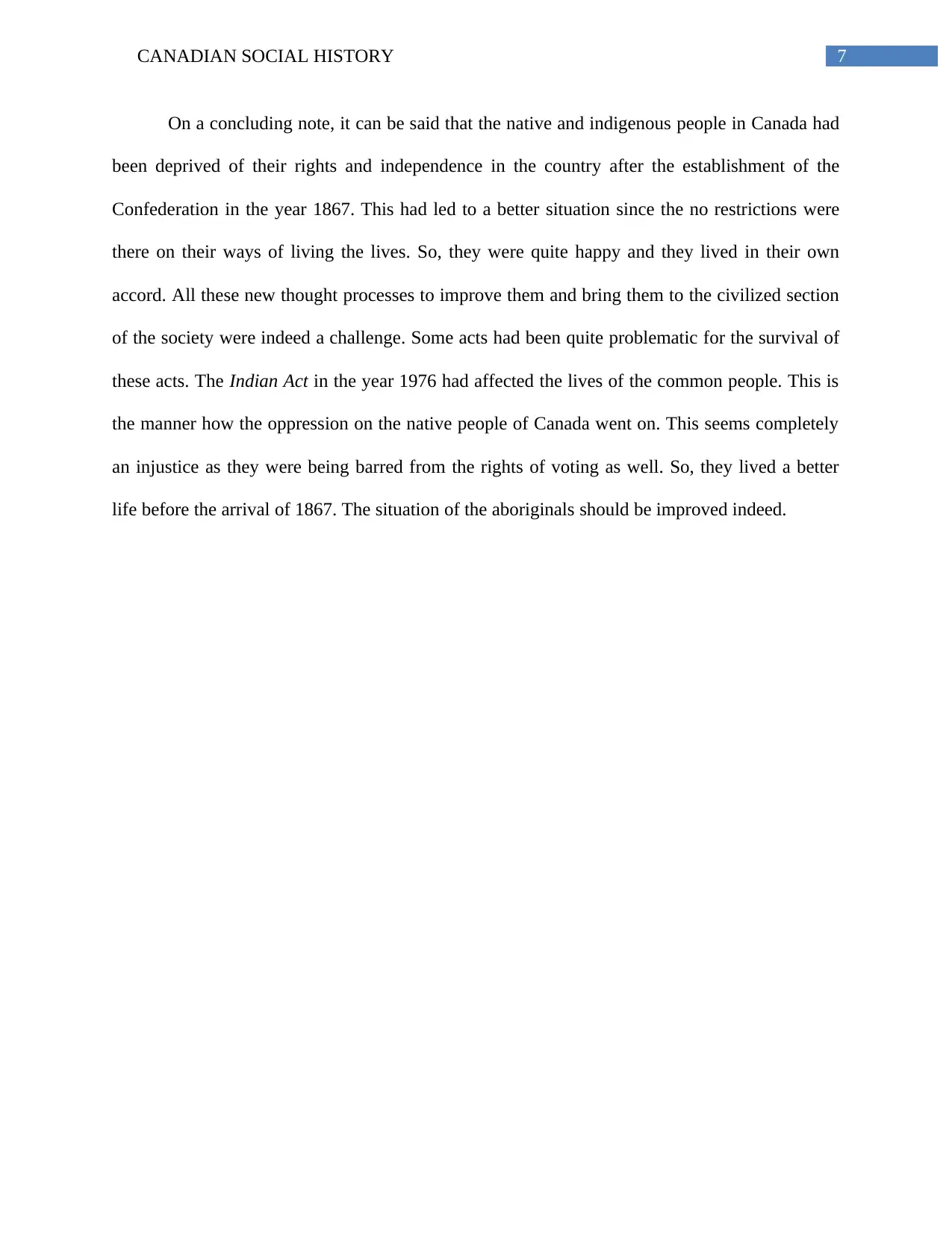
7CANADIAN SOCIAL HISTORY
On a concluding note, it can be said that the native and indigenous people in Canada had
been deprived of their rights and independence in the country after the establishment of the
Confederation in the year 1867. This had led to a better situation since the no restrictions were
there on their ways of living the lives. So, they were quite happy and they lived in their own
accord. All these new thought processes to improve them and bring them to the civilized section
of the society were indeed a challenge. Some acts had been quite problematic for the survival of
these acts. The Indian Act in the year 1976 had affected the lives of the common people. This is
the manner how the oppression on the native people of Canada went on. This seems completely
an injustice as they were being barred from the rights of voting as well. So, they lived a better
life before the arrival of 1867. The situation of the aboriginals should be improved indeed.
On a concluding note, it can be said that the native and indigenous people in Canada had
been deprived of their rights and independence in the country after the establishment of the
Confederation in the year 1867. This had led to a better situation since the no restrictions were
there on their ways of living the lives. So, they were quite happy and they lived in their own
accord. All these new thought processes to improve them and bring them to the civilized section
of the society were indeed a challenge. Some acts had been quite problematic for the survival of
these acts. The Indian Act in the year 1976 had affected the lives of the common people. This is
the manner how the oppression on the native people of Canada went on. This seems completely
an injustice as they were being barred from the rights of voting as well. So, they lived a better
life before the arrival of 1867. The situation of the aboriginals should be improved indeed.
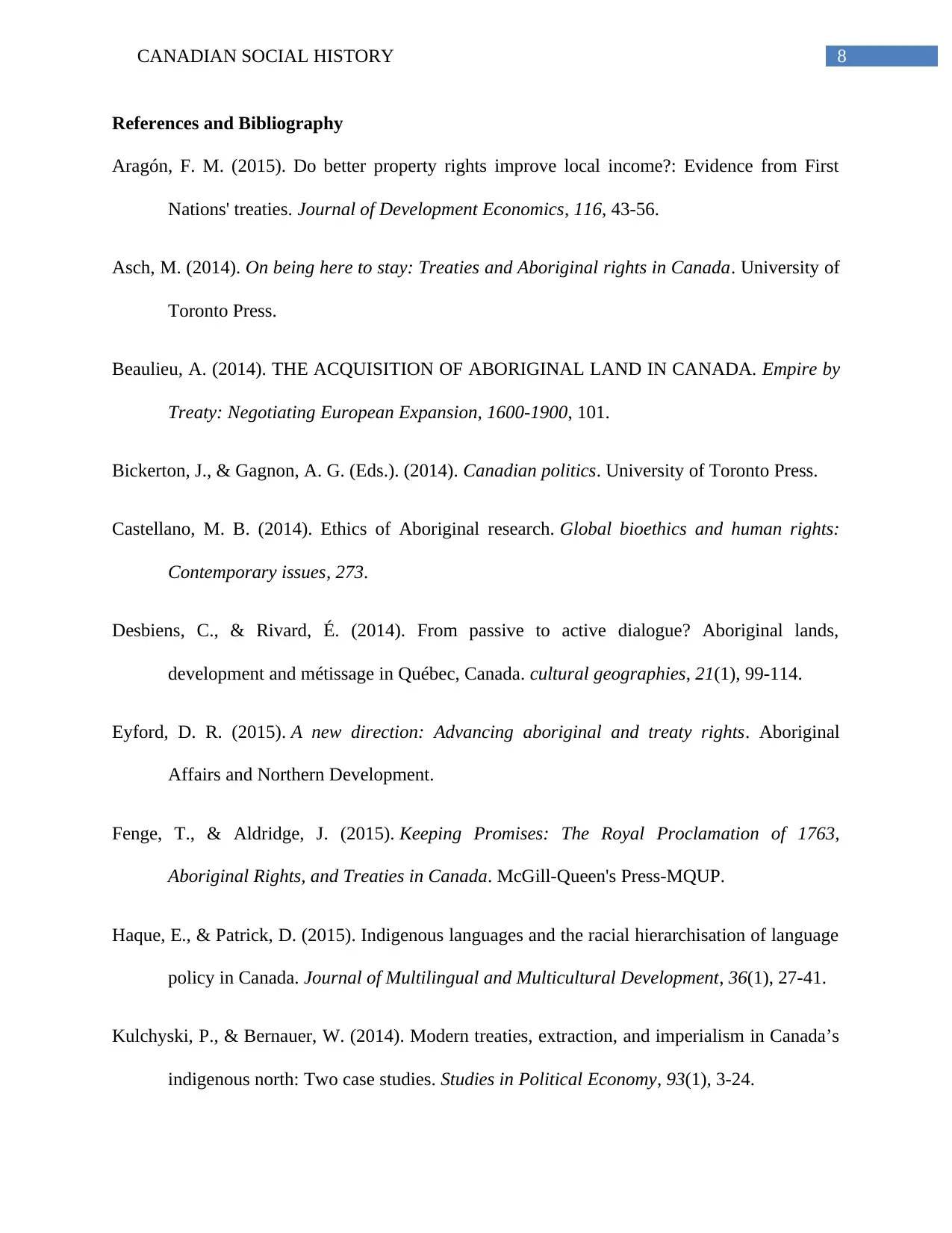
8CANADIAN SOCIAL HISTORY
References and Bibliography
Aragón, F. M. (2015). Do better property rights improve local income?: Evidence from First
Nations' treaties. Journal of Development Economics, 116, 43-56.
Asch, M. (2014). On being here to stay: Treaties and Aboriginal rights in Canada. University of
Toronto Press.
Beaulieu, A. (2014). THE ACQUISITION OF ABORIGINAL LAND IN CANADA. Empire by
Treaty: Negotiating European Expansion, 1600-1900, 101.
Bickerton, J., & Gagnon, A. G. (Eds.). (2014). Canadian politics. University of Toronto Press.
Castellano, M. B. (2014). Ethics of Aboriginal research. Global bioethics and human rights:
Contemporary issues, 273.
Desbiens, C., & Rivard, É. (2014). From passive to active dialogue? Aboriginal lands,
development and métissage in Québec, Canada. cultural geographies, 21(1), 99-114.
Eyford, D. R. (2015). A new direction: Advancing aboriginal and treaty rights. Aboriginal
Affairs and Northern Development.
Fenge, T., & Aldridge, J. (2015). Keeping Promises: The Royal Proclamation of 1763,
Aboriginal Rights, and Treaties in Canada. McGill-Queen's Press-MQUP.
Haque, E., & Patrick, D. (2015). Indigenous languages and the racial hierarchisation of language
policy in Canada. Journal of Multilingual and Multicultural Development, 36(1), 27-41.
Kulchyski, P., & Bernauer, W. (2014). Modern treaties, extraction, and imperialism in Canada’s
indigenous north: Two case studies. Studies in Political Economy, 93(1), 3-24.
References and Bibliography
Aragón, F. M. (2015). Do better property rights improve local income?: Evidence from First
Nations' treaties. Journal of Development Economics, 116, 43-56.
Asch, M. (2014). On being here to stay: Treaties and Aboriginal rights in Canada. University of
Toronto Press.
Beaulieu, A. (2014). THE ACQUISITION OF ABORIGINAL LAND IN CANADA. Empire by
Treaty: Negotiating European Expansion, 1600-1900, 101.
Bickerton, J., & Gagnon, A. G. (Eds.). (2014). Canadian politics. University of Toronto Press.
Castellano, M. B. (2014). Ethics of Aboriginal research. Global bioethics and human rights:
Contemporary issues, 273.
Desbiens, C., & Rivard, É. (2014). From passive to active dialogue? Aboriginal lands,
development and métissage in Québec, Canada. cultural geographies, 21(1), 99-114.
Eyford, D. R. (2015). A new direction: Advancing aboriginal and treaty rights. Aboriginal
Affairs and Northern Development.
Fenge, T., & Aldridge, J. (2015). Keeping Promises: The Royal Proclamation of 1763,
Aboriginal Rights, and Treaties in Canada. McGill-Queen's Press-MQUP.
Haque, E., & Patrick, D. (2015). Indigenous languages and the racial hierarchisation of language
policy in Canada. Journal of Multilingual and Multicultural Development, 36(1), 27-41.
Kulchyski, P., & Bernauer, W. (2014). Modern treaties, extraction, and imperialism in Canada’s
indigenous north: Two case studies. Studies in Political Economy, 93(1), 3-24.
⊘ This is a preview!⊘
Do you want full access?
Subscribe today to unlock all pages.

Trusted by 1+ million students worldwide
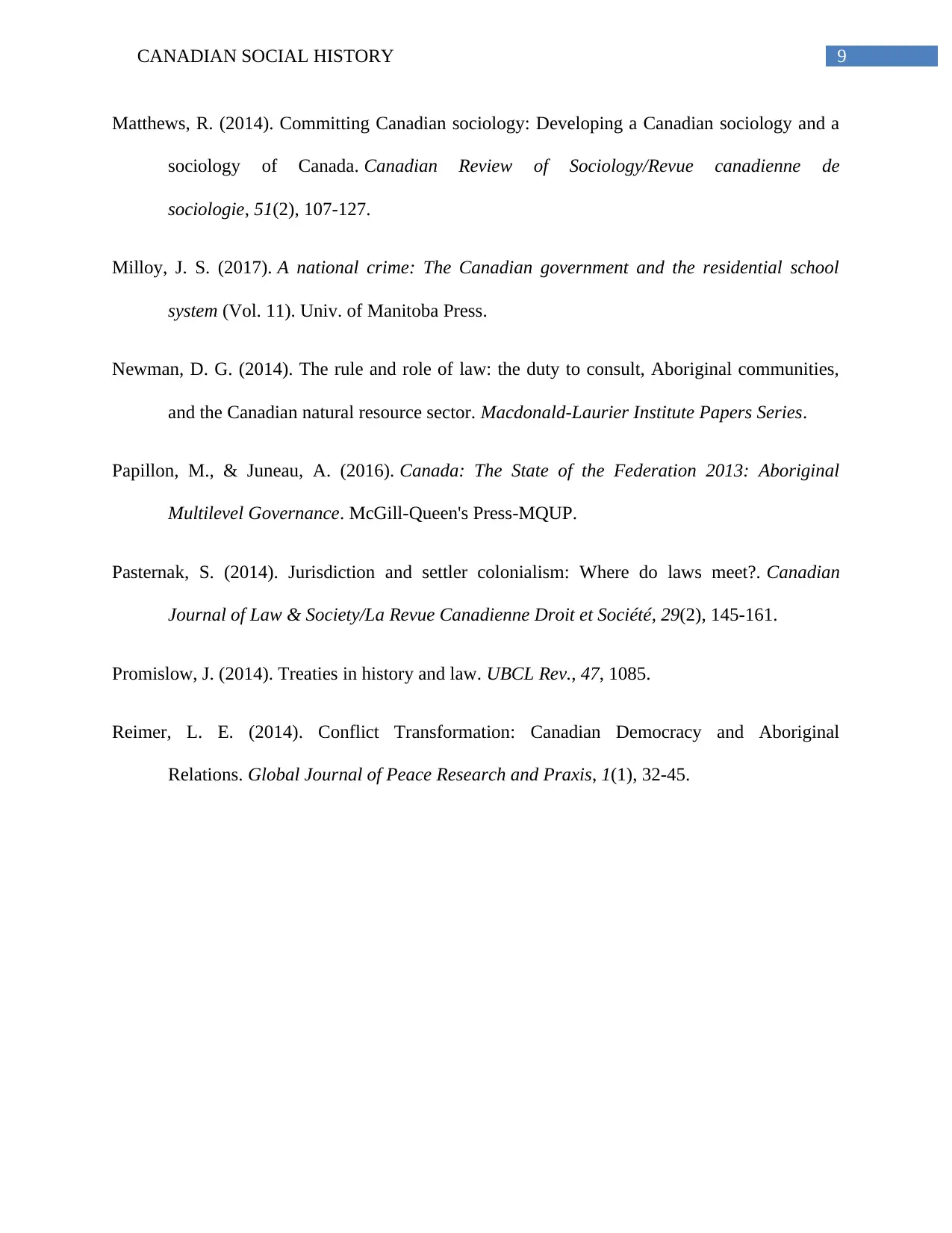
9CANADIAN SOCIAL HISTORY
Matthews, R. (2014). Committing Canadian sociology: Developing a Canadian sociology and a
sociology of Canada. Canadian Review of Sociology/Revue canadienne de
sociologie, 51(2), 107-127.
Milloy, J. S. (2017). A national crime: The Canadian government and the residential school
system (Vol. 11). Univ. of Manitoba Press.
Newman, D. G. (2014). The rule and role of law: the duty to consult, Aboriginal communities,
and the Canadian natural resource sector. Macdonald-Laurier Institute Papers Series.
Papillon, M., & Juneau, A. (2016). Canada: The State of the Federation 2013: Aboriginal
Multilevel Governance. McGill-Queen's Press-MQUP.
Pasternak, S. (2014). Jurisdiction and settler colonialism: Where do laws meet?. Canadian
Journal of Law & Society/La Revue Canadienne Droit et Société, 29(2), 145-161.
Promislow, J. (2014). Treaties in history and law. UBCL Rev., 47, 1085.
Reimer, L. E. (2014). Conflict Transformation: Canadian Democracy and Aboriginal
Relations. Global Journal of Peace Research and Praxis, 1(1), 32-45.
Matthews, R. (2014). Committing Canadian sociology: Developing a Canadian sociology and a
sociology of Canada. Canadian Review of Sociology/Revue canadienne de
sociologie, 51(2), 107-127.
Milloy, J. S. (2017). A national crime: The Canadian government and the residential school
system (Vol. 11). Univ. of Manitoba Press.
Newman, D. G. (2014). The rule and role of law: the duty to consult, Aboriginal communities,
and the Canadian natural resource sector. Macdonald-Laurier Institute Papers Series.
Papillon, M., & Juneau, A. (2016). Canada: The State of the Federation 2013: Aboriginal
Multilevel Governance. McGill-Queen's Press-MQUP.
Pasternak, S. (2014). Jurisdiction and settler colonialism: Where do laws meet?. Canadian
Journal of Law & Society/La Revue Canadienne Droit et Société, 29(2), 145-161.
Promislow, J. (2014). Treaties in history and law. UBCL Rev., 47, 1085.
Reimer, L. E. (2014). Conflict Transformation: Canadian Democracy and Aboriginal
Relations. Global Journal of Peace Research and Praxis, 1(1), 32-45.
1 out of 10
Related Documents
Your All-in-One AI-Powered Toolkit for Academic Success.
+13062052269
info@desklib.com
Available 24*7 on WhatsApp / Email
![[object Object]](/_next/static/media/star-bottom.7253800d.svg)
Unlock your academic potential
Copyright © 2020–2025 A2Z Services. All Rights Reserved. Developed and managed by ZUCOL.





